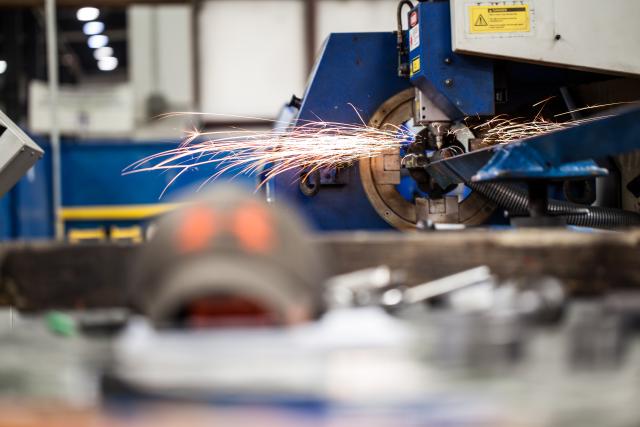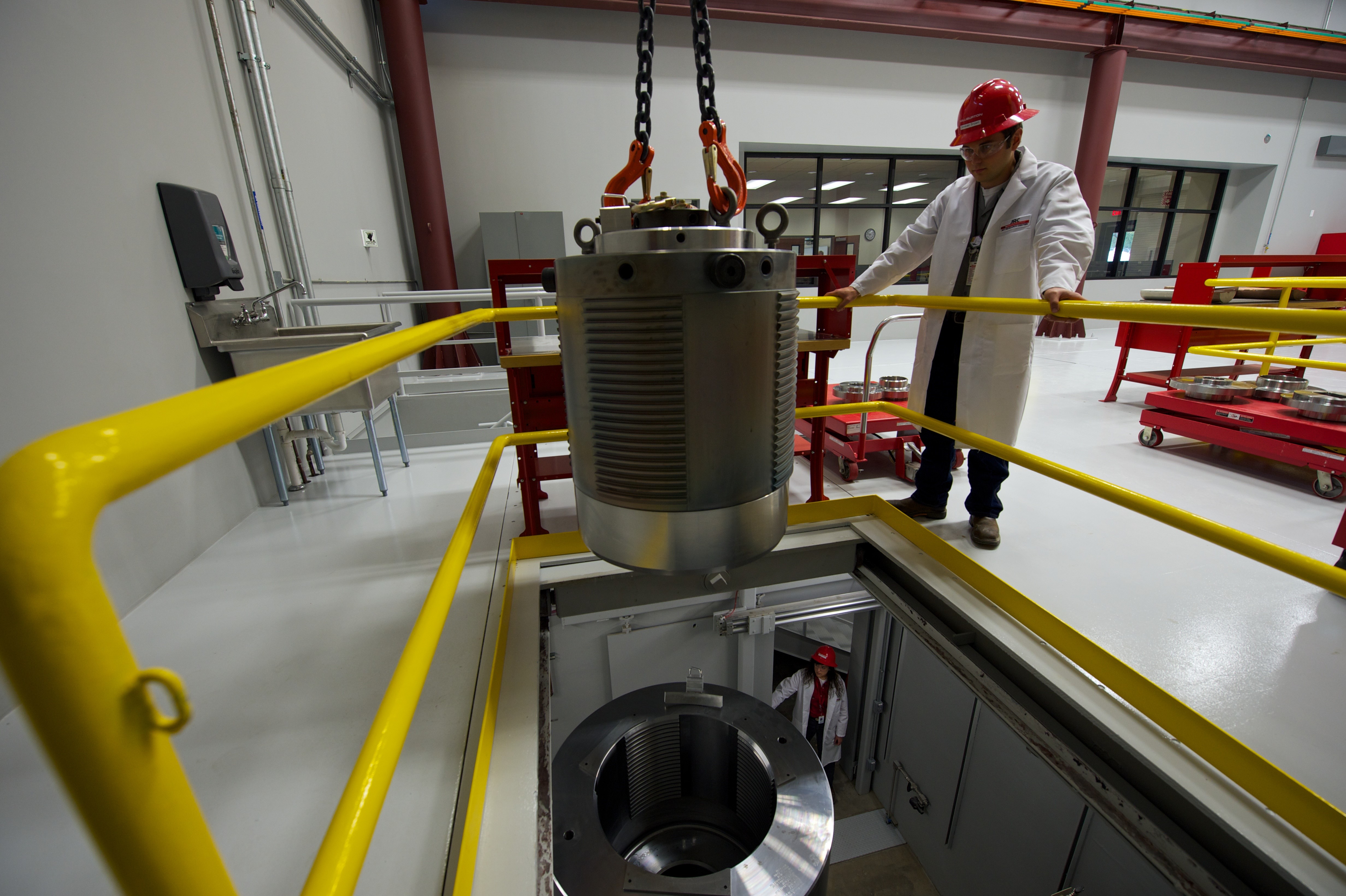
An automatic laser is used in perforating gun manufacturing. (Source: Owen Oil Tools)
PERFORATING SYSTEMS INDUSTRY UPDATE:
The zenith of the drilling rig count in the U.S. occurred on Dec. 28, 1981. There were 4,530 rigs in the U.S. drilling about 30,000 to 35,000 mostly vertical wells per year. On April 12, 2019, the rig count was 1,022 rigs. Even at that number, the industry is still drilling 30,000 to 35,000 mostly horizontal wells per year.
“I was a field engineer when I first started my career. I would go out and shoot maybe 10 guns per well. Today in a horizontal environment, we shoot 50 stages. We might shoot 10 guns per stage. We are shooting 500 guns in a well, an order of magnitude higher,” said George Patton, product development manager for the Owen Oil Tools division of Core Laboratories.
“One of the challenges for us is that we have to build more guns, more charges, more detonating cord, more detonators and more switches. For all the technology that has been around for decades, we have to be able to manufacture more than we have ever done in the past. At the same time, we need to be more cost effective.”
That demand for more equipment has led to other challenges. “Just the volume of the business is stretching the supply chain really thin,” said James Barker, Halliburton technical chief for perforating technology. “There are shortages in steel for the gun carriers and even explosive powders for the shaped charges. There have been significant shortages in those arenas over the last year, especially the explosive powders.”
That has led Halliburton to introduce new frac charges based on the explosive pentaerythritol tetranitrate (PETN). “That’s really a polymer-coated PETN for enhanced handling and safety. It was released in 2019,” he said.
The increased efficiency of the drilling rigs and the shift to longer laterals in horizontal wells have impacted perforating systems. “The whole horizontal environment has changed the nature of our business enormously. A lot of the ideas we used to accept in the vertical environment are being challenged in the horizontal environment,” Patton said.
Companies are also beginning to measure the efficiency of perforating systems with defects per million opportunities (DPMO). “The reliability has increased to about 99% or better, but even more is demanded. As the industry gets better and better, you kind of lose whatever 99.x% means from a success standpoint. If you cast it in DPMO, then it amplifies how good you really are,” Barker said.
While the sheer demand for perforating guns is straining the system, manufacturing companies continue to work with operators and service companies to improve the technology for perforating systems.
Consistency of hole size
With the advent of horizontal wells, what has really become a critical factor is the consistency of the hole size. In a horizontal well, the guns will sit on the low side of the casing. The perforation hole size can vary around the casing.
“You have one shot right next to the casing on the bottom of the casing. Then, you have a shot on the top of the casing that is going across the fluid gap between the gun and the casing. The performance of that charge is diminished. It is no longer what the API [American Petroleum Institute] specs are,” Patton said.
Frequently, the hole size consistency can be a 20% standard deviation with a standard conventional charge, he explained. “You might have an average 0.36-in. hole, but in the 6 o’clock position, the hole size could be 0.49 in. and 0.24 in. in the 12 o’clock position. We can change the shape of the jet that makes the perforation so we can get a hole size in all six positions around the casing down to a 3% standard deviation,” he said.
Owen Oil Tools’ consistent-hole-size charge is branded HERO PerFRAC, which is now its largest selling series of charges. This product line was initially introduced in 2014 and relaunched in 2016. Since then, the company has improved the standard deviation from less than 10% to less than 3%.

(Source: Owen Oil Tools)
“We have talked to the operating companies about their specific casings because hole size varies for each casing size, weight and grade. The gun sizes may change if you have large or small casing. We’ve brought in clients, and they have given us samples of their casing. We shot those at Owen Oil Tools’ facility in Godley, Texas. We demonstrated what we say about consistent hole size is true. They have used them in their wells and gotten better results, lower frac pressures, fracs being put away and even better production,” Patton said.
Another product being rebranded is the company’s ZERO 180 Perforating System, which is now being called Pinpoint Perforating System. This orients the gun downhole in a horizontal well. Society of Petroleum Engineer papers have documented that an operator should shoot in the 12 o’clock and 6 o’clock positions for the best frac performance.
“We have a tool that orients downhole in a horizontal well so you can shoot in any direction that you want,” Patton said. “We’ve got people who want to shoot in three directions—at 12 o’clock, 10 o’clock and 2 o’clock. That is very client specific.”
Another aspect of the Pinpoint Perforating System is avoiding fiber-optic control lines running down the outside of the casing with costs of about $1 million each on an average horizontal well. You have to be able to determine where the control line is. There are some logging tools and techniques to determine this. Once you know where they are, you can design your guns to shoot away from them,” he said. The company has had success in 2017 and 2018 with several wells in Canada that use control lines.
Wireline-conveyed pump-down technologies
The gun systems for plug-and-perf operations to support hydraulic fracturing in the shale fields are getting better and better, Halliburton’s Barker said. “By that I mean premiums are now placed on things like fast turnaround time, efficiency at the well site and reliability so that you minimize idle time for the frac pumps,” he said.
“Trying to get the DPMO number better just drives you to be better in your gun designs where the parts come together quicker and easier for our field organization to assemble. That has led to our company being one of the pioneers in loaded guns from the manufacturer. We can load guns here in a controlled environment at the shaped-charge plant and ship loaded guns to the districts,” he continued.
For this type of market, the industry is still trying to determine what the optimal perforating design for their frac is. “The trend now seems to be shorter guns with fewer shots per cluster but [to] have more clusters per stage. What might be eight to 12 clusters per stage may now be around 20 clusters. Even as I say the trend is toward shorter guns, we just had some orders come in for longer frac guns with 15 to 18 shots. I think the jury is still out with the production and frac pumping companies themselves,” he said.
The propellant suppliers are getting into the schemes as well by enhancing the perforation with some overpressure from a propellant. “Some of these are now being tried in the field to see if that helps lower breakdown pressures and makes more efficient fracs at the well site,” he said.
Coated PETN does alleviate the safety concerns. There are powder shortages with the traditional explosives that are used every day in the oil and gas industry—RDX (cyclotrimethylene trinitramine) and HMX (cyclotetramethylene tetranitramine).
“PETN, if it is not manufactured properly, can be a more sensitive explosive. Our introduction is a polymer-coating that covers the crystals of the explosive, which brings its sensitivity to the RDX and HMX levels,” Barker said. “What we see is no real clear winner. Maybe there never will be. There is always some wrinkle from field to field or area to area. But there is a broad product offering right now. There seems to be no universal gun system such as the six shots, 60-degree phasing. There are other options.”
Tubing-conveyed perforating, testing
For tubing-conveyed perforating systems, there is a trend toward larger diameter gun systems—the 6½-in. and 7-in. gun systems for offshore work with high shot densities of larger explosive quantities. This technology is still being requested by customers.
“What is new technology is the modeling software for job design because you are looking at two things. When you shoot those big guns, how do you make sure you’ve optimized your production through controlling the dynamic underbalance and other geomechanical considerations of the formation?” Barker asked. “Because of the large explosive contents, you also have to make sure that structurally your guns are protected from collapse and parting, and that you don’t corkscrew the tubing or unseat the packers. There are now quite a few advancements made in the modeling software that predict both what is happening in the reservoir and how you protect your perforating gun string and completion string from damage.”
The last item involves testing that is specifically available in the flow laboratories.
“The industry has known for a long while that it is doing a good job of directing the industry in perforator penetration prediction. API 19B uses concrete targets shot on surface. Folks have now realized that is not really telling the true picture,” he said. “People are now beginning to realize that this also applies to the hole diameter that is produced in the casing. We’re beginning to see now that this is a much more complex mechanism than was envisioned previously when using hole-size predictions about what happens behind the casing based on surface-condition targets. Instead, those shots need to be done under simulated wellbore conditions if you want to have an accurate representation of what is happening.”

Manufacturing challenges
Owen Oil Tools has had to gear up its manufacturing operations and improve the technology in manufacturing, including the techniques the company uses to manufacture because it needs to be more cost effective, Patton said.
“Operating companies are coming to us now wanting us to build thousands of guns instead of tens of guns. They want us to be able to do it cheaper than what we could for tens of guns. We’re automating our manufacturing processes more than we have ever done. We’re using robotics more,” he said. “The whole manufacturing operation is changing dramatically. The demand for Owen products is greater than it has ever been. We sell millions of charges every year and hundreds of miles of guns. We need to be very efficient in services that we provide in perforating for those companies to bring oil and gas to the worldwide community at an effective price.”
One of the manufacturing challenges for Owen Oil Tools is that historically it has not had relationships with the operating companies. “One of the things we’ve been doing the last couple of years is spending more time and talking directly with the operating companies concerning the value that we bring to their operations,” Patton said.
The company does not want to lose its relationship with the service companies that distribute its products to the operators, but they are spending more time with the operating companies. “That was something we didn’t do 20 years ago. But we give them a lot more today by working directly with the operating companies while maintaining relationships with our historical clients,” he said.
Recommended Reading
TPG Adds Lebovitz as Head of Infrastructure for Climate Investing Platform
2024-02-07 - TPG Rise Climate was launched in 2021 to make investments across asset classes in climate solutions globally.
Air Products Sees $15B Hydrogen, Energy Transition Project Backlog
2024-02-07 - Pennsylvania-headquartered Air Products has eight hydrogen projects underway and is targeting an IRR of more than 10%.
NGL Growth Leads Enterprise Product Partners to Strong Fourth Quarter
2024-02-02 - Enterprise Product Partners executives are still waiting to receive final federal approval to go ahead with the company’s Sea Port Terminal Project.
Sherrill to Lead HEP’s Low Carbon Solutions Division
2024-02-06 - Richard Sherill will serve as president of Howard Energy Partners’ low carbon solutions division, while also serving on Talos Energy’s board.
Magnolia Appoints David Khani to Board
2024-02-08 - David Khani’s appointment to Magnolia Oil & Gas’ board as an independent director brings the board’s size to eight members.





